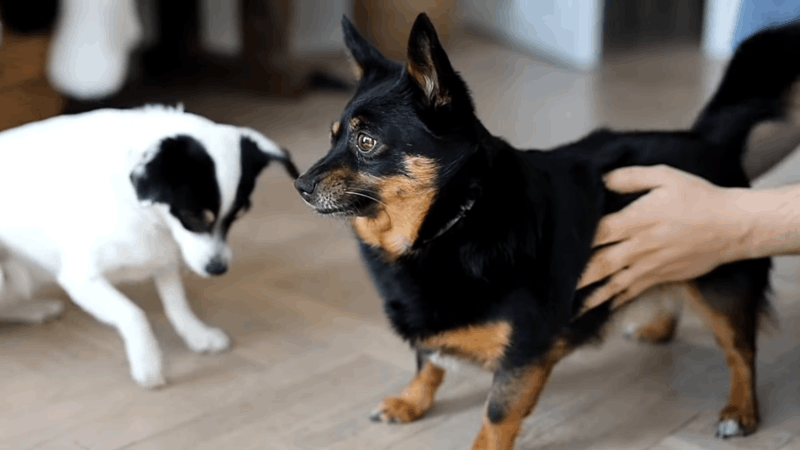No products in the cart.
As a prospective treatment solution for managing Intervertebral Disc Disease (IVDD), a prevalent spinal condition in certain breeds, CBD for IVDD in dogs has gained popularity. Pet owners are increasingly turning to CBD, seeking its potential benefits for alleviating pain and inflammation in dogs with IVDD. But what does CBD do for dogs, and how can it assist in providing relief from this debilitating condition?
In this blog, we’ll explore the potential effects of CBD for IVDD in dogs and its role in supporting their overall well-being.
What is IVDD in Dogs?

IVDD stands for Intervertebral Disc Disease, and it is a common spinal condition that affects dogs. The breeds at risk of getting IVDD are Dachshunds and Basset Hounds, the dogs with long bodies and short legs. In the spine, the intervertebral discs act as cushions between the vertebrae, however, in IVDD, these discs can degenerate or become herniated, putting pressure on the spinal cord. Pain, nerve damage, aggression in dogs and even paralysis in severe cases are the results of this.
Pet owners should consult with a veterinarian to have a better chance of successful treatment. Early detection and appropriate care can significantly improve the quality of life for dogs affected by IVDD.
What Causes IVDD in Dogs?
The exact cause of IVDD in dogs is not always clear, however, its development can be contributed by many factors
- Genetics: Certain dog breeds are more prone to IVDD due to genetic predisposition. Breeds with long bodies and short legs including Dachshunds, Beagles, and Corgis will have a higher risk.
- Age: IVDD is more common in middle-aged to older dogs (between the ages of 3 and 7 years).
- Excessive weight: Carrying excess weight puts additional strain on the spine and increases the likelihood of disc degeneration.
- Trauma: Physical trauma or injury to the spine can damage the intervertebral discs, leading to IVDD. Jumping from heights, accidents, or rough play can be contributing factors.
- Inactive lifestyle: Lack of regular exercise and muscle support can weaken the spinal structures, making dogs more susceptible to IVDD.
- Nutrition: Poor diet and inadequate nutrition can impact overall spinal health.
- Conformation: Dogs with structural issues in their spine or abnormal posture may have an increased risk of developing IVDD.
It’s essential to note that while some factors may increase the risk of IVDD, it can also occur spontaneously without any apparent cause. Early recognition of symptoms and proper veterinary care can help manage the condition and prevent further complications. If you suspect your dog may have IVDD, seeking prompt veterinary attention is crucial for an accurate diagnosis and appropriate treatment.
Signs of IVDD in Dogs
The severity and location of the affected disc(s) are the signs to recognize the Intervertebral Disc Disease (IVDD) in dogs. Here are some common signs to look out for
- Back pain: Dogs with IVDD may exhibit signs of discomfort or pain in the back or neck area. They may yelp, cry, or flinch when touched or when they move in certain ways.
- Difficulty walking: IVDD can cause weakness or difficulty in walking, especially in the hind legs. Dogs may drag their limbs, wobble, or have an uncoordinated gait.
- Hunched posture: Affected dogs may hold their back in a hunched position or have a stiff, arched back.
- Reluctance to move: Dogs with IVDD may be hesitant to jump, climb stairs, or engage in activities they once enjoyed due to pain and discomfort.
- Loss of balance: They may have difficulty maintaining balance, leading to stumbling or falling.
- Lameness: One or more limbs may appear weak or paralyzed, depending on the location of the affected disc.
- Muscle atrophy: Over time, muscle wasting or atrophy may occur in the affected limbs due to reduced nerve function.
- Loss of bladder or bowel control: Dogs may lose control of their bladder and bowel function in severe cases where the spinal cord is severely compressed.
To determine the cause accurately, please evaluate a proper veterinarian because these signs can also be associated with other health conditions. If you notice any of these signs in your dog, especially if they worsen or develop suddenly, please seek veterinary attention for an ideal examination and appropriate treatment as soon as possible.
IVDD in Dogs Stages
Intervertebral Disc Disease (IVDD) in dogs is typically classified into five stages. These stages help veterinarians assess the severity of the condition and determine the appropriate treatment:
Stage I:
- This stage is characterized by mild signs of IVDD.
- Dogs may have mild back pain and may be reluctant to jump or engage in certain activities.
- Neurological deficits are absent or minimal, with normal limb reflexes.
Stage II:
- In this stage, there is a partial loss of motor function.
- Dogs may exhibit difficulty walking, a wobbly gait, or weakness in the hind limbs.
- Some dogs may still be able to walk, but their coordination is noticeably affected.
Stage III:
- This stage involves a severe loss of motor function.
- Dogs are often unable to walk or stand on their own, and their hind limbs may be partially or completely paralyzed.
- Deep pain perception is often diminished or absent in the affected areas.
Stage IV:
- Dogs in this stage are completely paralyzed in both hind limbs.
- They have no voluntary movement and no deep pain perception in the affected areas.
- Loss of bladder and bowel control is common at this stage.
Stage V:
- This is the most severe stage of IVDD.
- Dogs are completely paralyzed in all four limbs (tetraplegia).
- They may also have difficulty breathing if the nerves controlling the respiratory muscles are affected.
It’s crucial to understand that dogs with IVDD may progress through these stages at different rates, and not all cases will follow the exact progression. Early recognition of symptoms and immediate veterinary care are essential for the best chances of recovery and to prevent further neurological damage.
How to Prevent IVDD in Dogs?

Preventing Intervertebral Disc Disease (IVDD) in dogs involves adopting certain measures that can help reduce the risk of developing this spinal condition
- Maintain a healthy weight: The stress on their spine and decreases the risk of disc degeneration can be reduced by keeping your dog at a healthy weight.
- Regular exercise: Engage your dog in regular, low-impact exercise to strengthen their muscles and support their spine. Avoid activities that involve excessive jumping or twisting, especially for breeds prone to IVDD.
- Avoid overexertion: Rough play or high-impact activities can increase the risk of spinal injury so please protect your furry friends from these.
- Use proper support: Provide appropriate support and use ramps or stairs to help your dog access higher surfaces, such as beds or couches, instead of allowing them to jump.
- Watch their posture: Encourage your dog to maintain proper posture, and avoid allowing them to sit or lie in positions that strain their back.
- Nutrition: Feed your dog a balanced diet to support overall spine and joint health.
- Regular vet checkups: Schedule regular veterinary check ups to monitor your dog’s spinal health and catch any potential issues early on.
- Provide comfortable resting spots: Offer your dog comfortable and supportive resting spots that are not too high or low.
- Educate yourself: Learn about the signs of IVDD and other spinal conditions, so you can recognize any potential issues and seek immediate veterinary attention if needed.
These preventive measures can reduce the risk of IVDD in dogs, however, certain breeds are more susceptible due to their genetics so please consider carefully. If you have a breed prone to IVDD, being extra vigilant and proactive in taking preventative measures can significantly contribute to your dog’s spinal health and overall well-being.
CBD for IVDD in Dogs and How to Use It Effectively?

CBD has gained popularity as a potential treatment option for various health conditions in dogs, including Intervertebral Disc Disease (IVDD) and it potentially provides pain relief and anti-inflammatory effects.
While some pet owners and veterinarians have reported positive outcomes with CBD for managing pain and inflammation associated with IVDD in dogs, it’s essential to approach its use cautiously and under veterinary supervision. There is limited scientific research on the specific effects of CBD for IVDD in dogs, and its safety and efficacy can vary between individuals.
It’s crucial to remember that every dog is unique, and CBD can not work for all dogs. Always prioritize your dog’s safety and well-being by seeking professional veterinary advice and monitoring their response to CBD treatment closely. At Pet CBD Club, you can believe in nurturing the well-being of your beloved furry companions naturally. The premium CBD products are thoughtfully crafted to enhance your pet’s quality of life, promoting health, happiness, and harmony.
Is CBD for IVDD in Dogs Better Than Other Treatments?
The combination of interventions, including rest, pain management, anti-inflammatory medications, physical therapy, and, in some cases, surgical intervention are the proper treatment approach for IVDD in dogs. These conventional treatments have been well-established and have a track record of success in managing IVDD and improving the quality of life for affected dogs.
CBD has gained popularity for its potential analgesic and anti-inflammatory properties and may offer some relief for dogs with IVDD. However, its effectiveness can vary between individuals, and the optimal dosage and duration of use for IVDD have not been standardized.
When considering CBD for IVDD in dogs, it is essential to consult with a qualified veterinarian who can evaluate your dog’s specific condition, medical history, and overall health. Depending on the best available evidence and clinical experience, veterinarians can provide personalized treatment recommendations and guidance.
To ensure your furry friend’s well-being and safety, please seek professional veterinary advice before using CBD for IVDD in dogs and do not rely on unproven or untested treatments. Always discuss treatment options thoroughly with your veterinarian to make informed decisions about your dog’s care.
The Side Effect of Using CBD for IVDD in Dogs
Like any supplement or medication, CBD for IVDD in dogs can potentially cause side effects, especially if misused or if your pet is sensitive to its effects. When using CBD for IVDD or any other condition in dogs, it’s essential to be aware of possible side effects, which may include
- Dry mouth: CBD can temporarily reduce saliva production, leading to increased thirst and dry mouth in some dogs.
- Drowsiness: CBD for IVDD in dogs may cause drowsiness or sedation, particularly when higher doses are administered.
- Lowered blood pressure: In some cases, CBD for IVDD in dogs may lead to a temporary drop in blood pressure and it is the result of lightheadedness or mild dizziness.
- Digestive issues: Some dogs may experience mild gastrointestinal upset, such as nausea or diarrhea, when first starting CBD for IVDD in dogs.
- Interactions with medications: CBD for IVDD in dogs can potentially interact with certain medications, especially those metabolized by the liver. It’s crucial to consult with a veterinarian to avoid any adverse drug interactions.
- Allergic reactions: In rare cases, dogs may be allergic to CBD or the carrier oils used in CBD products, leading to allergic reactions.
- Increased liver enzymes: Some studies point that high doses of CBD have been associated with elevated liver enzymes in dogs. Regular monitoring may be necessary for dogs on long-term CBD therapy.
It’s important to emphasize that individual responses to CBD can vary, and not all dogs will experience side effects. If you notice any adverse reactions or unusual behavior in your dog after starting CBD treatment, discontinue its use and seek veterinary advice immediately.
Before using CBD or any other supplement or medication for your dog’s IVDD, it’s crucial to consult with a veterinarian. A qualified veterinarian can help determine the appropriate dosage, monitor your dog’s response to treatment, and address any potential concerns related to CBD use.
Conclusion
CBD for IVDD in dogs can be a potential treatment option to manage pain and inflammation associated with this spinal condition.Before using CBD for IVDD in dogs, consulting with a qualified veterinarian is crucial to determine the appropriate dosage and monitor the dog’s response. While promising, further research is needed to fully understand CBD’s effectiveness and safety for IVDD in dogs.
Hello, I am Hazel Bennett, an experienced copywriter specializing in the fascinating topic of CBD for dogs. With a passion for pet wellness and extensive knowledge of CBD’s potential benefits, I am here to provide you with informative and engaging content.



